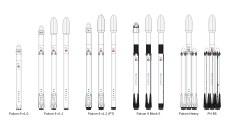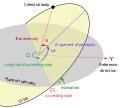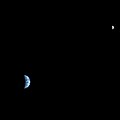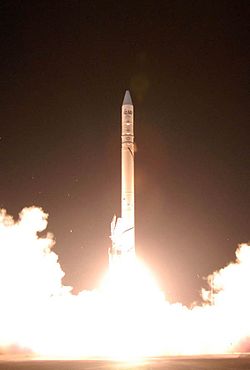Artificial satellites in low inclination orbits are rarely placed in retrograde orbit. This is partly due to the extra velocity (and propellant) required...
5 KB (558 words) - 11:31, 14 October 2024
natural satellites have prograde orbits around their planets. Prograde satellites of Uranus orbit in the direction Uranus rotates, which is retrograde to the...
42 KB (4,754 words) - 06:00, 1 June 2025
Sun. A Sun-synchronous orbit is useful for imaging, reconnaissance, and weather satellites, because every time that the satellite is overhead, the surface...
14 KB (1,657 words) - 19:06, 16 March 2025
are in such orbits, as are many artificial satellites and pieces of space debris. Moons by contrast are not in a heliocentric orbit but rather orbit their...
31 KB (3,455 words) - 19:37, 27 October 2024
equivalently, between 0° and −90°) is said to be in a retrograde orbit. A satellite in a direct orbit with an orbital period less than one day will tend to move...
14 KB (1,948 words) - 19:20, 17 March 2025
appear to travel in an oblong retrograde loop around the planet. . In contrast to true satellites, quasi-satellite orbits lie outside the planet's Hill...
14 KB (1,659 words) - 20:38, 13 January 2025
List of Falcon 9 and Falcon Heavy launches (2020–2022) (category All Wikipedia articles written in American English)
first time, a satellite launched initially into shell 4 has maneuvered its orbit to join the shell 1 satellites. Starlink 3680 was launched in Mar 2022 and...
287 KB (12,588 words) - 00:50, 8 May 2025
describing artificial satellites orbiting the Earth, because they have zero apogee drift. An inclination of exactly 90° is a polar orbit, in which the...
11 KB (1,470 words) - 02:33, 8 May 2025
known to have natural satellites. A planet usually has at least around 10,000 times the mass of any natural satellites that orbit it, with a correspondingly...
43 KB (3,564 words) - 16:01, 3 May 2025
synchronous orbits are employed by artificial satellites used for communication, such as geostationary satellites. For natural satellites, which can attain...
8 KB (813 words) - 03:33, 1 June 2025
causing rapid orbital decay if left unchecked. A number of artificial satellites have been placed into transatmospheric Earth orbits, usually due to...
3 KB (358 words) - 17:32, 30 May 2025
above one location on the planet. Unlike geosynchronous satellites, satellites in low orbit have a small field of view and can only observe and communicate...
19 KB (2,128 words) - 02:29, 5 June 2025
communications satellites, is sometimes called the Clarke orbit. Similarly, the collection of artificial satellites in this orbit is known as the Clarke Belt. In technical...
49 KB (4,893 words) - 06:24, 20 May 2025
geocentric orbit, Earth-centered orbit, or Earth orbit involves any object orbiting Earth, such as the Moon or artificial satellites. In 1997, NASA estimated...
17 KB (1,997 words) - 15:59, 21 April 2025
interplanetary probes. First satellites from each country are included. Not included are most Earth science satellites, commercial satellites or crewed missions...
77 KB (864 words) - 14:58, 28 May 2025
communications satellites, is sometimes called the Clarke Orbit. Similarly, the collection of artificial satellites in this orbit is known as the Clarke Belt. In technical...
33 KB (3,236 words) - 12:26, 4 June 2025
higher orbit. Some P-11 reconnaissance satellites were launched from KH-4A. At least two launches of Discoverer were used to test satellites for the...
80 KB (5,789 words) - 14:06, 4 June 2025
thruster burns to keep the active craft in the same orbit as its target. For many low Earth orbit satellites, the effects of non-Keplerian forces, i.e...
13 KB (1,543 words) - 04:47, 23 November 2024
Earth orbit of artificial satellites, which have no measurable effect on the motion of Earth. The nodal precession of more massive, natural satellites like...
6 KB (911 words) - 17:51, 19 May 2025
gravitationally bound to one of the planets in a planetary system, either natural or artificial satellites, follow orbits about a barycenter near or within that...
57 KB (8,123 words) - 08:45, 4 June 2025
The areosynchronous orbits (ASO) are the synchronous orbits for artificial satellites around the planet Mars. They are the martian equivalent of the geosynchronous...
3 KB (374 words) - 00:13, 28 May 2025
Tidal acceleration (category Orbit of the Moon)
that have an orbital period that is shorter than the primary's rotational period, or that orbit in a retrograde direction. These satellites will have a...
37 KB (4,801 words) - 15:43, 24 May 2025
Kozai mechanism (category Orbital perturbations)
a prograde and a retrograde motion. The effect has been found to be an important factor shaping the orbits of irregular satellites of the planets, trans-Neptunian...
28 KB (3,256 words) - 22:23, 28 May 2025
Lagrange point (redirect from Lagrange orbit)
an excellent location for satellites, as orbit corrections, and hence fuel requirements, needed to maintain the desired orbit are kept at a minimum. For...
51 KB (5,819 words) - 07:28, 1 June 2025
Ofeq (redirect from Ofeq reconnaissance satellite)
Most satellites are launched eastward to gain a boost from the Earth's rotational speed. However, Ofeq satellites are launched westward, in retrograde orbits...
7 KB (520 words) - 09:41, 2 June 2025
Standard gravitational parameter (category Orbits)
10−6. During the 1970s to 1980s, the increasing number of artificial satellites in Earth orbit further facilitated high-precision measurements, and the...
15 KB (1,492 words) - 06:26, 25 May 2025
Queqiao-2 (redirect from Queqiao-2 relay satellite)
25° 1992 × 18679 km retrograde orbit. Queqiao 2 relay satellite and radio observatory is based on the CAST 2000 bus from DFH Satellite, a subsidiary of the...
30 KB (2,985 words) - 05:04, 28 May 2025
extraterrestrial orbiters is a listing of spacecraft that achieved an extraterrestrial orbit. The first artificial object in heliocentric orbit was Luna 1 (1959)...
28 KB (512 words) - 06:47, 8 March 2025
communication and observation of the Martian surface, no artificial satellites have been placed in this orbit due to the technical complexity of achieving and...
8 KB (802 words) - 22:37, 12 April 2025
Ephemeris (redirect from Orbital trajectory)
the trajectory of naturally occurring astronomical objects and artificial satellites in the sky, i.e., the position (and possibly velocity) over time....
16 KB (1,700 words) - 00:10, 25 May 2025


















